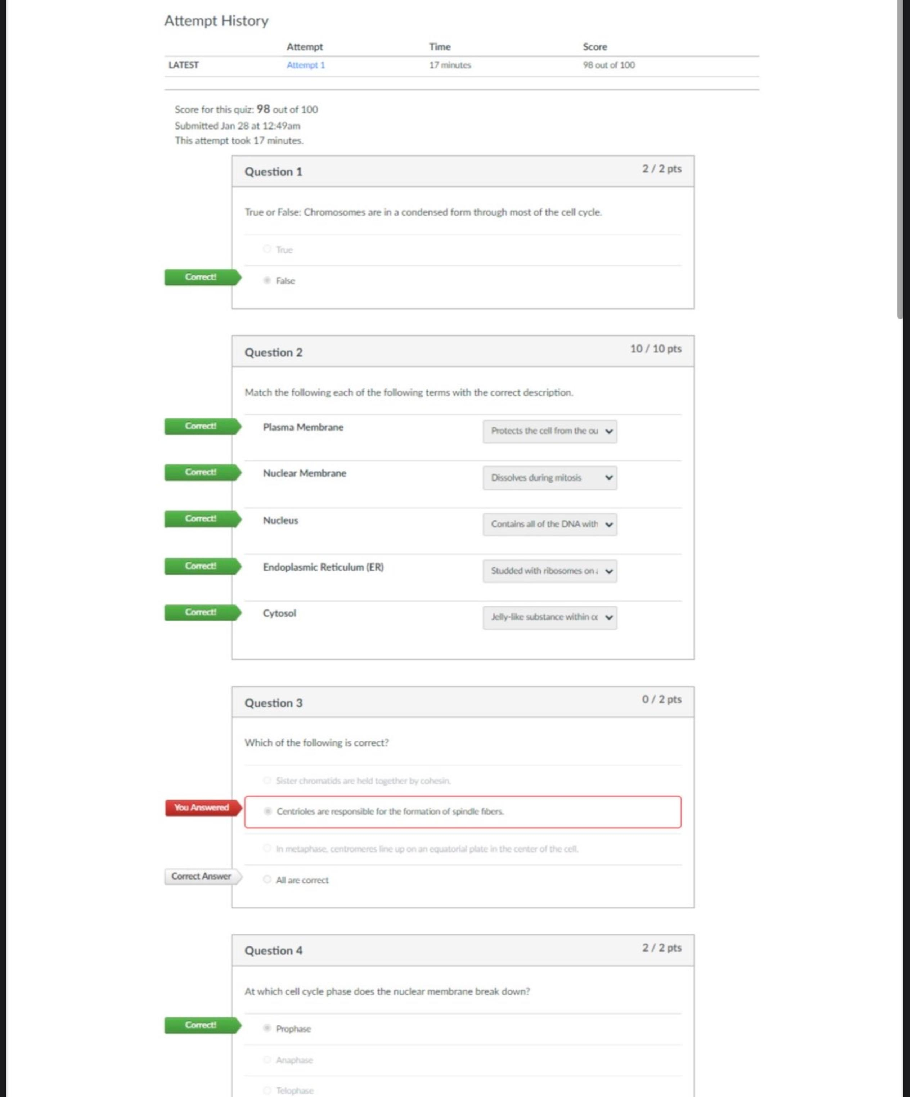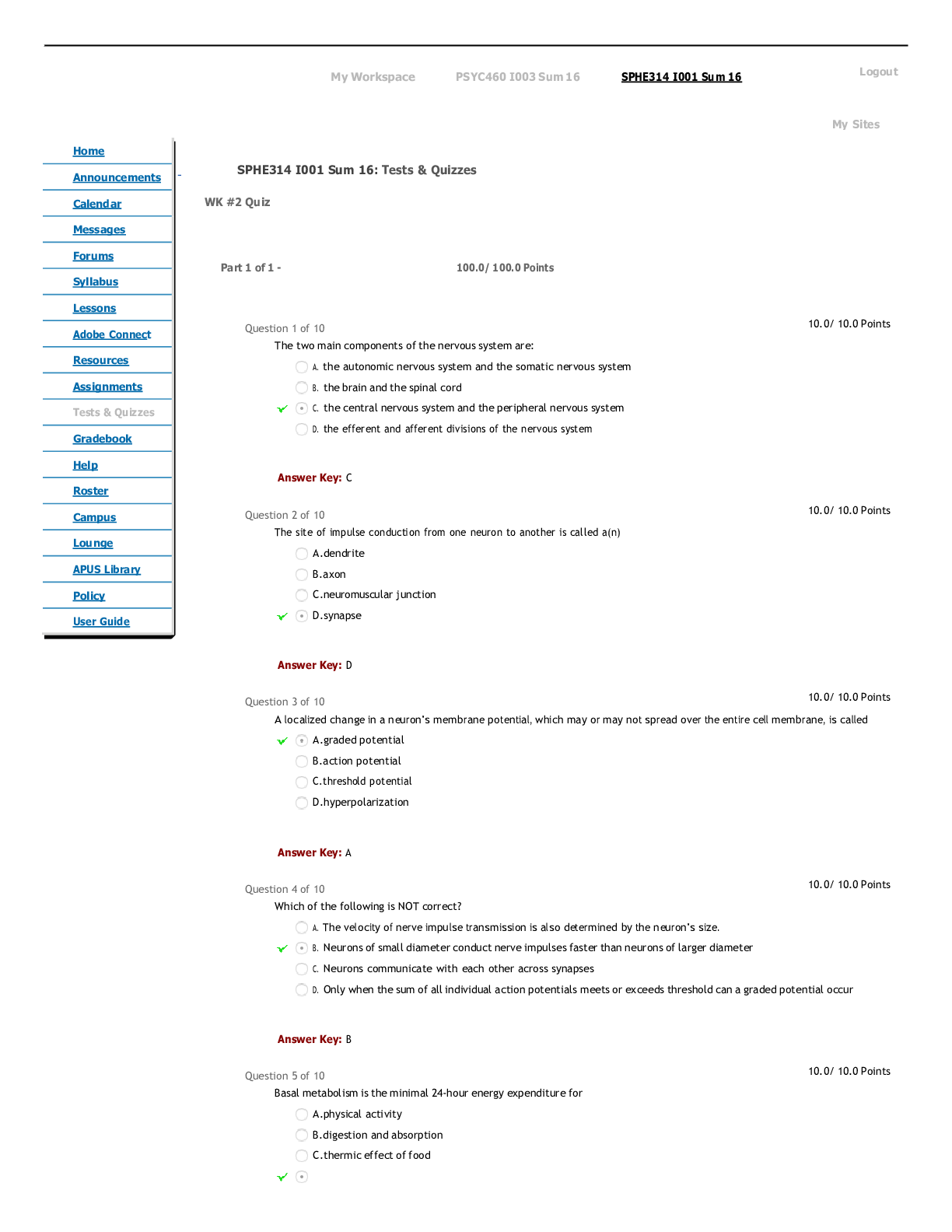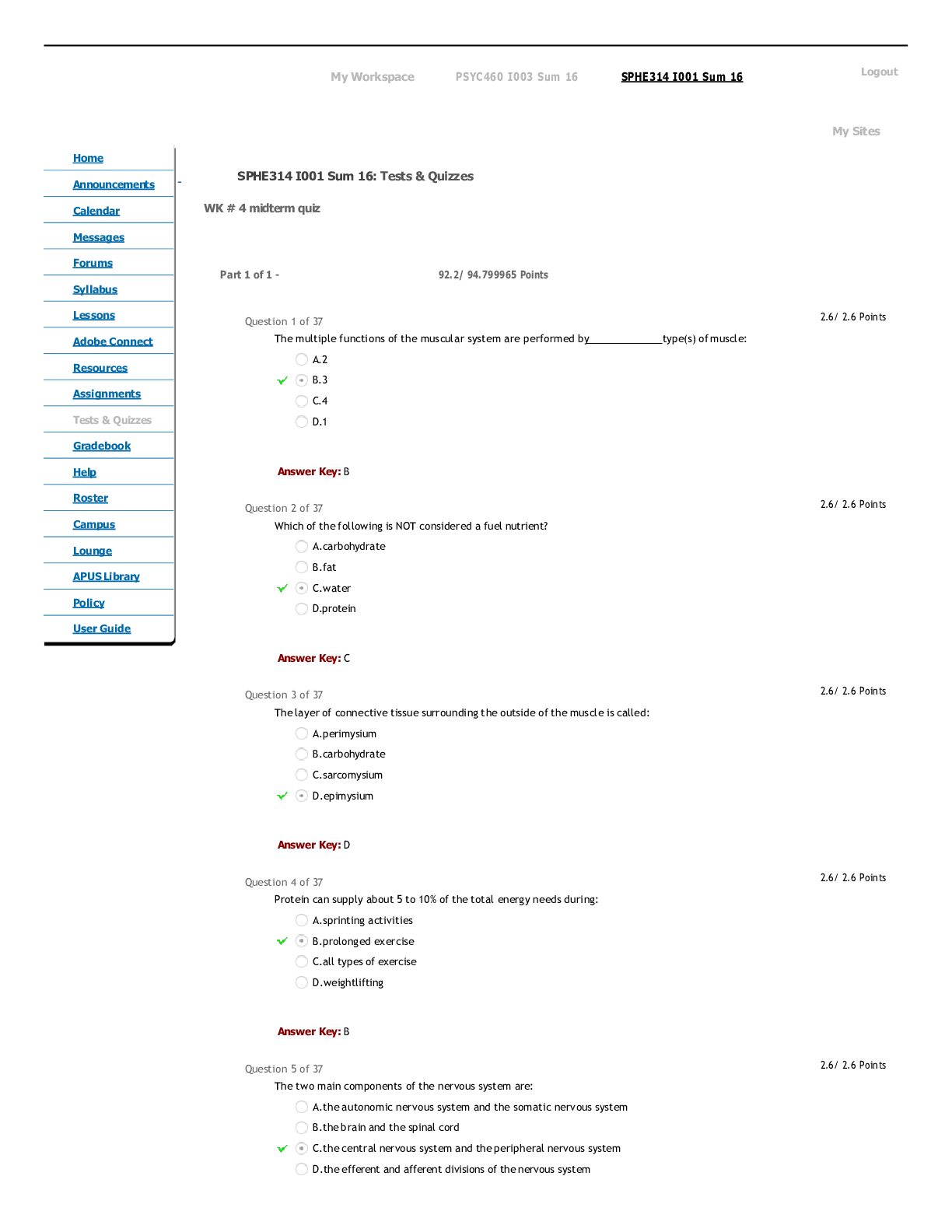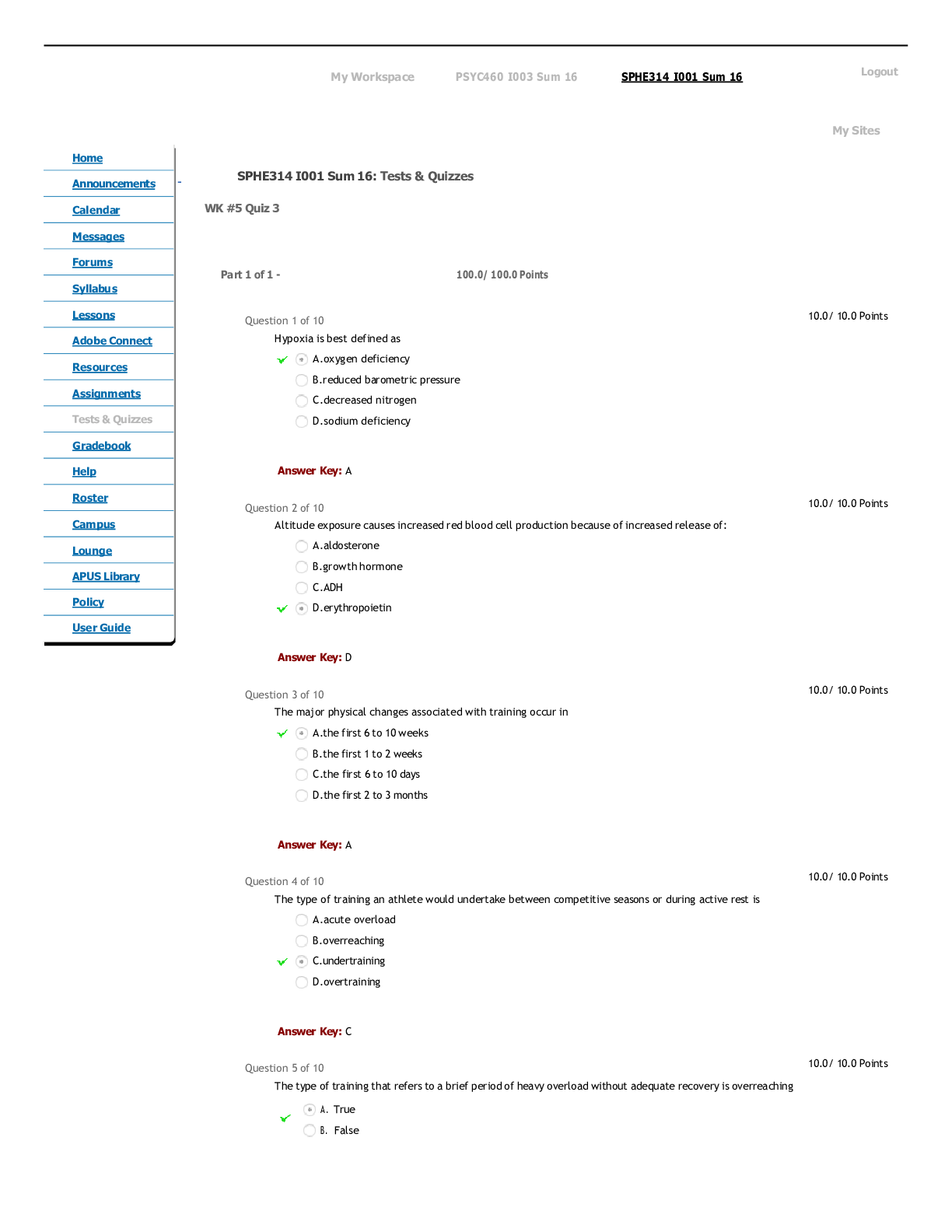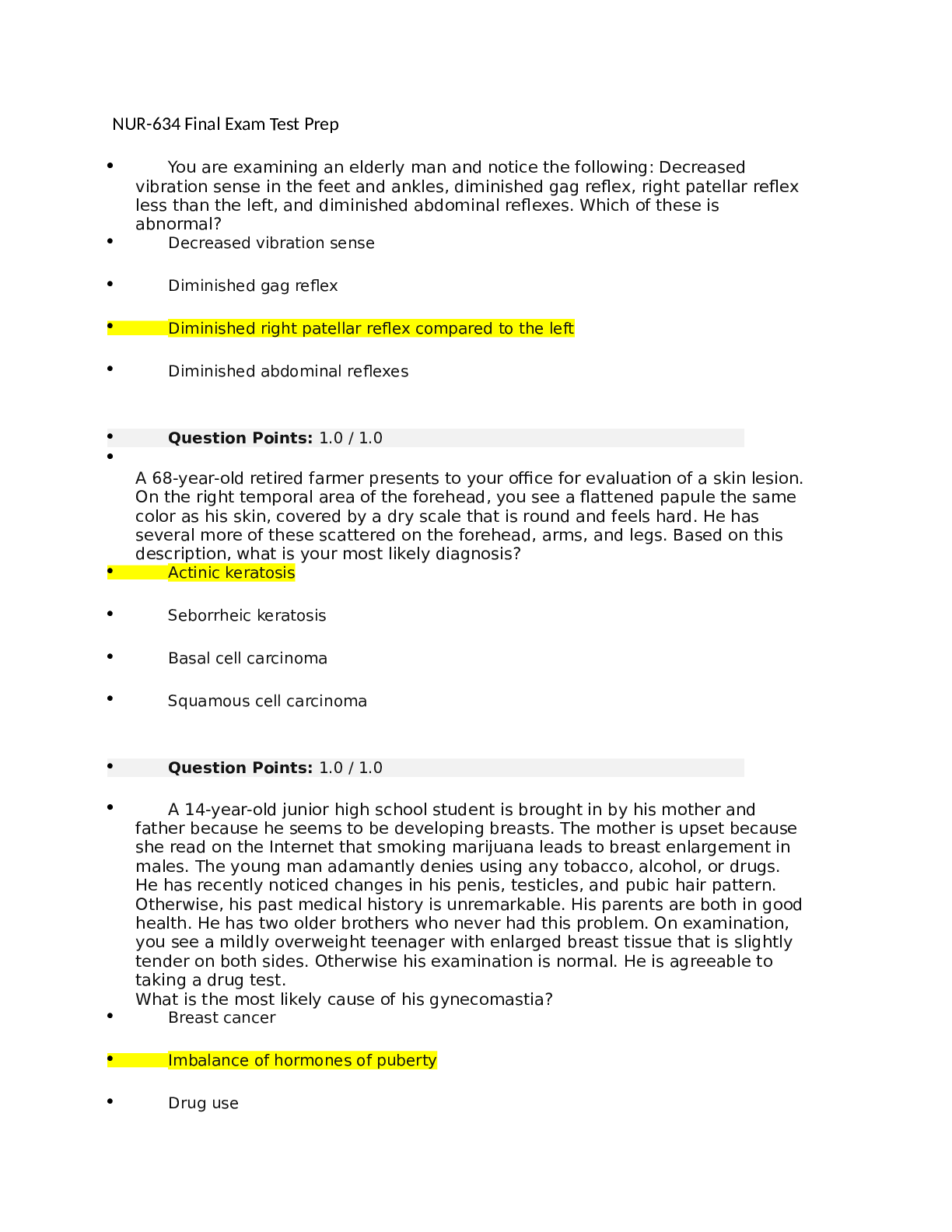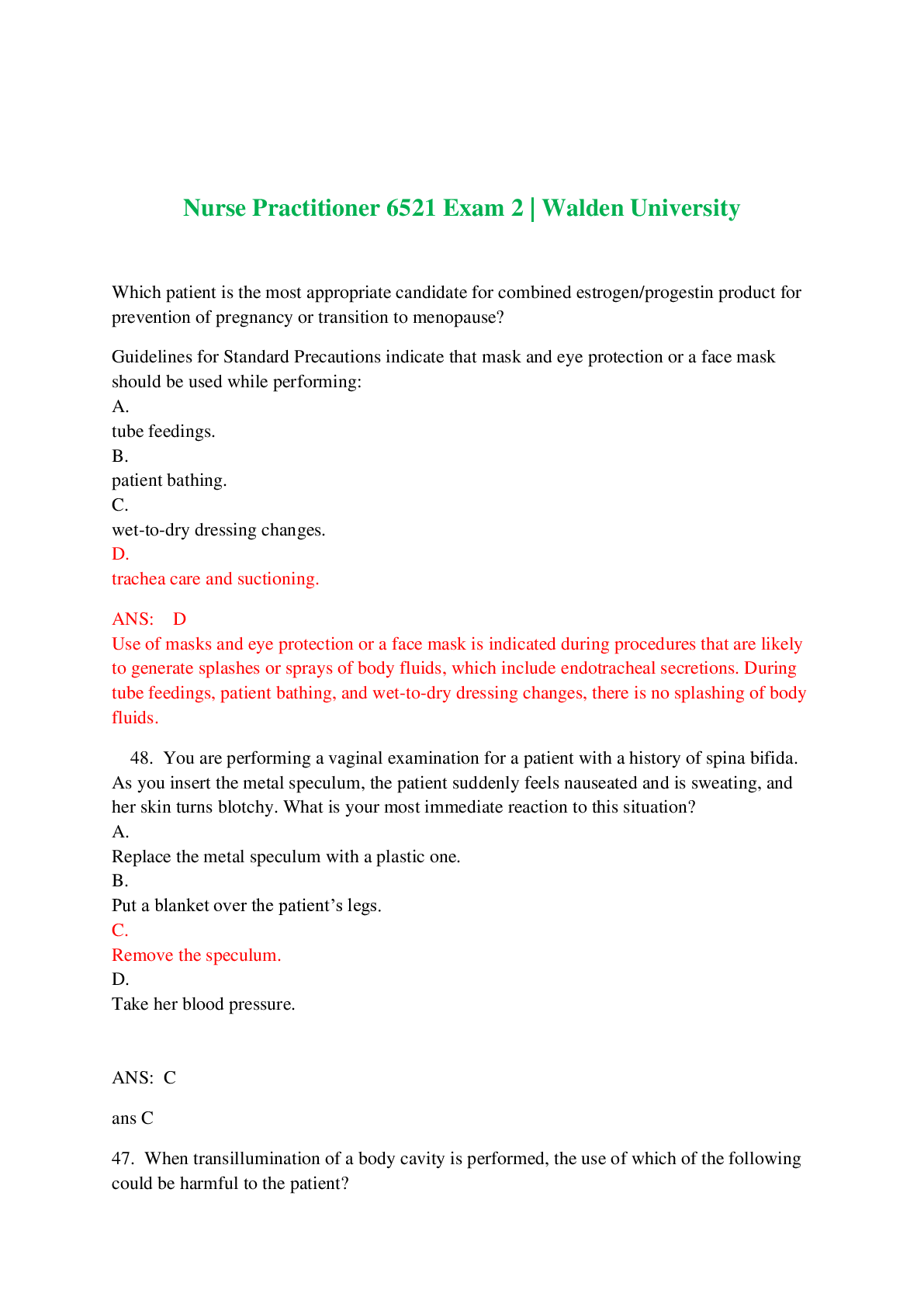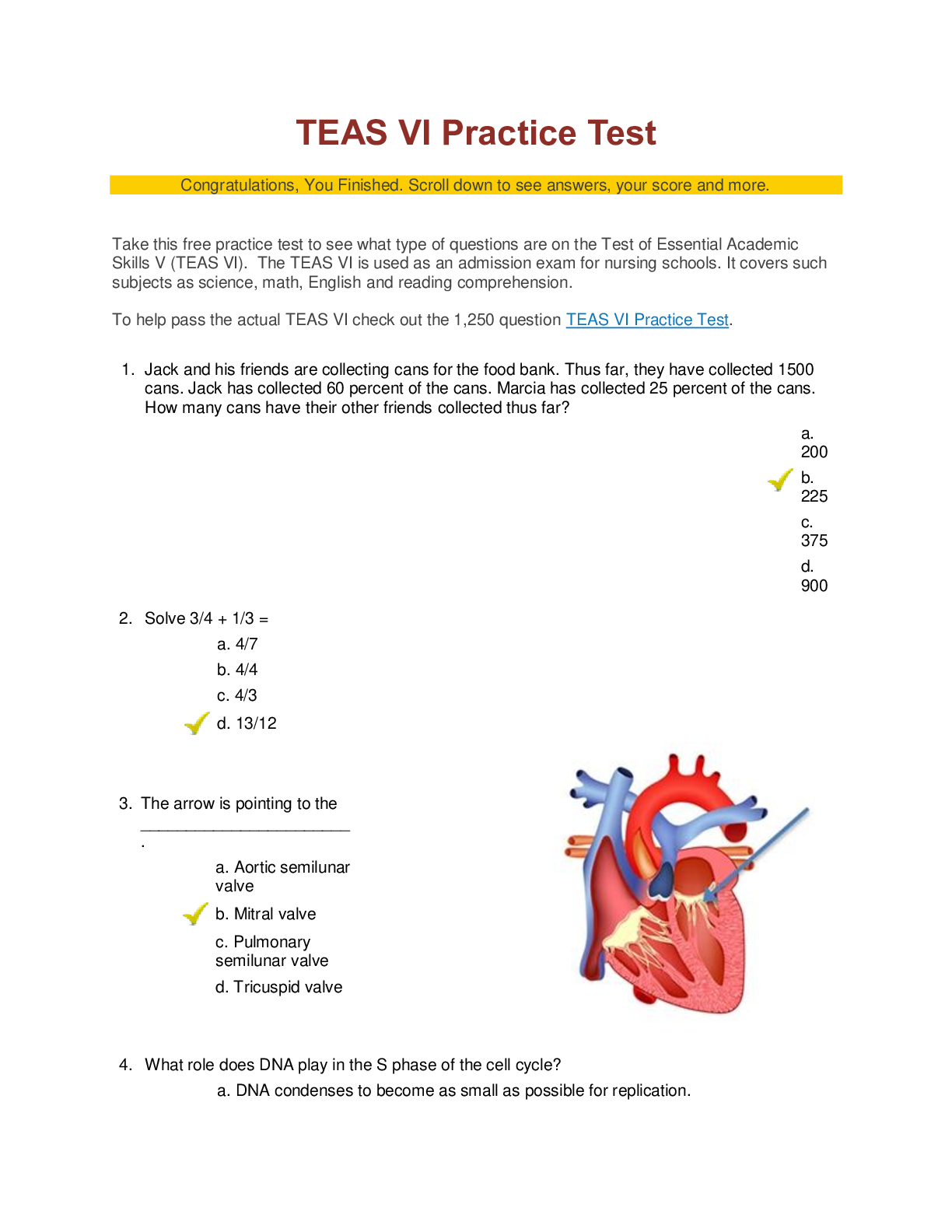NURS 324 Exam 2 | Questions and Answers (Complete Solutions)
Document Content and Description Below
NURS 324 Exam 2 | Questions and Answers (Complete Solutions) Your patient presents with the failure of the testes to descend into the abdominal cavity. What is your diagnosis? Cryptorchidism Which o... f the following are treatments for cryptorchidism (SATA)? A) surgery B) hormonal therapy C) removal D) chemo and radiation E) all of the above Which of the following are risk factors for cryptorchidism (SATA)? A) low birth weight B) premature birth C) family history D) Jacob's syndrome E) fetal growth restriction F) alcohol, cigarette, or pesticide exposure during pregnancy G) all of the above Which of the following are complications of cryptorchidism (SATA)? A) testicular cancer B) fertility problems C) prostate cancer D) testicular torsion E) rectal cancer F) trauma, inguinal hernia G) all of the above Your patient presents with the urethral meatus on the dorsal surface of the penis (or within the clitoris of the vagina). What is your diagnosis? Epispadias What is the main issue experienced with epispadias? trouble propelling semen Your patient presents with the urethral meatus on the ventral surface of the penis. What is your diagnosis? Hypospadias Hypospadias is one of the most common... birth defects in males (5 out of every 1,000) Which of the following are causes of hypospadias (SATA)? A) genetics B) fertility treatments C) mother 35+ years and/or overweight D) mother with diabetes E) exposure to smoking or pesticides F) prematurity G) all of the above Your patient presents with difficulty urinating, ballooning of prepuce, weak and thin urine stream, spraying urination, and the foreskin unable to be retracted over the glans penis. What is your diagnosis? Phimosis Which of the following are causes of phimosis (SATA)? A) genetics B) mother 35+ years C) scarring from circumcision D) poor hygiene E) infection or inflammation F) loss of skin elasticity G) infrequent erections H) all of the above When is phimosis most common? within first three years of life Your patient presents with the foreskin retracted over the glans penis and is not able to be returned. What is your diagnosis? Paraphimosis When and why does paraphimosis become a medical emergency? penis becomes constricted and edematous; the lack of blood flow and lead to gangrene Your patient presents with a prolonged, painful erection. What is your diagnosis? Priapism Why does priapism occur? too much blood shunting within the corpus cavernosum; blood becomes trapped Which of the following are causes of priapism (SATA)? A) sickle cell disease B) leukemia C) thrombocytopenia D) trauma or tumors E) diabetes mellitus F) spinal cord injury or neurologic disease G) drugs such as Viagra H) all of the above What ages is priapism most common? between 5 and 10, and 25 and 50 Your patient presents with severe pain in the testes, lower UTI symptoms, urethral discharge, fever, swelling in the scrotum of less than six weeks, and tenderness in the scrotum. What is your diagnosis? Epididymitis What leads to sterility in epididymitis? if abscesses and scar tissue forms on both sides Which of the following are causes of epididymitis (SATA)? A) unknown B) prostatitis C) bacterial or viral infections D) drug-induced E) vasculitis F) testicular cancer G) all of the above Which of the following are risk factors for epididymitis (SATA)? A) sexually active men younger than 35 that also have gonorrhea or chlamydia B) history of testicular torsion C) enteric pathogens D) bladder outlet obstruction E) frequent catheters F) all of the above Your patient presents with inflammation of the testes following an injury or infection. What is your diagnosis? Orchitis What is the most common cause of orchitis? Mumps What can lead to sterility in orchitis? atrophy of the testes on both sides Your patient presents with the accumulation of fluid between the layers of the tunica vaginalis or along the spermatic cord. What is your diagnosis? Hydrocele Hydrocele is the most common... disease of the testes Which of the following are causes of hydrocele (SATA)? A) inflammation B) infection C) trauma and tumors D) testicular torsion E) all of the above Your patient presents with the feeling of a "bag of worms" in the scrotum, scrotal heaviness, dull or aching pain on affected side, and dilation of the internal spermatic veins and pampiniform plexus. What is your diagnosis? Varicocele Give statistics of varicocele regarding percentage of cases based on age, unilateral vs bilateral, and incidence in male fertility clinics 15% adolescent and adult men 90% left side only 10% bilateral 40% found in male fertility clinics Which of the following are causes of varicocele (SATA)? A) increased hydrostatic pressure in left renal vein B) testicular cancer C) epididymitis D) incompetent or congenitally absent valves E) all of the above Your patient presents with testicular pain, intermittent or acute on-and-off pain, no pain relief on elevation of scrotum, scrotal swelling or edema, high-riding testicle, abdominal pain, and nausea and vomiting. What is your diagnosis? testicular torsion Why is testicular torsion a medical emergency? constriction of vascular supply and time-sensitive ischemia/necrosis of testicular tissue --> can lead to infarction or infertility What are the most common causes of testicular torsion? trauma and strenuous exercise Your patient presents with enlargement of the prostate gland, partially blocking the flow of urine from the bladder. What is your diagnosis? benign prostatic hyperplasia Which of the following are common complications of benign prostatic hyperplasia (SATA)? A) cystitis B) pyelonephritis C) hydronephrosis D) uremia E) hydroureters F) all of the above Which of the following are risk factors for benign prostatic hyperplasia (SATA)? A) imbalance of sex hormones B) drop in testosterone with age C) steady estrogen with age D) backup of blood during menstruation E) back up of ureters due to lack of bladder fully emptying F) all of the above Your patient presents with dysuria, difficulty urinating, dribbling, urinary urgency, nocturia, pain in the abdomen, groin, lower back perineum, or genitals, fever, chills, myalgia, and recurrent UTIs. What is your diagnosis? Prostatitis Define prostatitis and list the common causes inflammation of the prostate; gonorrhea, UTI, unknown Your patient presents with dysuria, frequency of urination, reduction in stream, nocturia, hematuria, nerve pain, bowel or bladder dysfunction, muscle spasms, bone or joint pain, weight loss, and fatigue. What is your diagnosis? prostate cancer Define prostate cancer the most common cancer in men and 2nd leading cause of cancer deaths Why is there a poor prognosis for prostate cancer? Due to location, it is very difficult to catch early; likely to have metastasized before it is caught Your patient aged 20 to 34 years presents with a testicular mass. What is your diagnosis? testicular cancer Define testicular cancer most common malignancy in men 20-34 Which of the following are risk factors for testicular cancer (SATA)? A) cryptorchidism B) testicular torsion C) gonadal dysgenesis D) family history E) caucasian F) HIV G) testicular atrophy H) all of the above Define infertility for males decreased sperm count, sperm abnormalities, hormonal deviations, physical impediments Define infertility for females ovulation dysfunction, hormonal deviations, physical obstructions, severe reproductive tract infections Your patient presents with a sensation of vaginal bulging, pelvic pressure, urinary frequency, incomplete bladder emptying, and defecatory dysfunction. What is your diagnosis? uterine prolapse Which of the following are risk factors for uterine prolapse (SATA)? A) African B) 35+ years C) high BMI D) vaginal delivery E) genetics F) all of the above Your patient presents with a feeling of pressure in the vagina or pelvis, feeling as if the bladder is not fully emptied, discomfort when lifting or coughing, urinary leakage, pain during sex and repeated UTIs. What is your diagnosis? Cystocele Define cystocele downward displacement of the bladder into the vagina due to trauma to muscles and ligaments during delivery or the atrophy of the pelvic floor muscles Your patient presents with constipation, fecal incontinence, and discomfort. What is your diagnosis? Rectocele Define rectocele downward displacement of the rectum into the vagina due to trauma to muscles and ligaments during delivery or the atrophy of the pelvic floor muscles Your patient presents with the absence of menstrual periods. What is your diagnosis? Amenorrhea Distinguish between primary and secondary amenorrhea primary - menstruation failed to begin secondary - menstruation ceased for more than a year Which of the following are causes of amenorrhea (SATA)? A) extreme depression B) depleted body fat C) pregnancy D) lack of gonadotropic hormones E) all of the above Your patient presents with dull to severe pelvic and lower back pain and painful or difficult menses. What is your diagnosis? Dysmenorrhea Which of the following are common causes of dysmenorrhea (SATA)? A) ovarian cancer B) endometriosis C) pelvic infections D) unknown E) fallopian tube rupture F) all of the above Your patient presents with excessive or prolonged bleeding during menstruation. What is your diagnosis? Menorrhagia Which of the following are common causes of menorrhagia (SATA)? A) ovarian cancer B) failure to ovulate C) complications during pregnancy D) tumors E) hormonal imbalance F) all of the above Your patient presents with bleeding in between menstrual periods or extreme irregularity of the cycle. What is your diagnosis? Metrorrhagia What is the common cause of metrorrhagia? abnormal building up and sloughing off of endometrial tissue --> hormonal imbalance or altered tissue response to hormones Your patient presents with endometrial tissue located outside its normal location. What is your diagnosis? Endometriosis What is a common cause of endometriosis? tissue pushed backward through fallopian tube during menstruation Which of the following are complications of endometriosis (SATA)? A) fibrosis B) scarring C) cancer D) infertility and dyspareunia E) miscarriage F) all of the above Your patient presents with hot flashes, night sweats, irregular periods, loss of libido, vaginal dryness, and mood swings. What is your diagnosis? Menopause What are two common complications of menopause? increased risk of heart disease and osteoporosis Your patient presents with lower abdominal pain, fever, chills, and leukorrhea. What is your diagnosis? pelvic inflammatory disease Define pelvic inflammatory disease (due to) inflammation of pelvic reproductive organs due to bacterial, fungal, viral, or parasitic infection Which of the following are complications of PID (SATA)? A) ovarian cancer B) ectopic pregnancy C) infertility D) subsequent infections - cervicitis, endometritis, salpingitis E) all of the above Your patient presents with high fever, rash, skin peeling, decreased blood pressure, GI complaints, elevated liver enzymes, and neuromuscular disturbances. What is your diagnosis? toxic shock syndrome What causes toxic shock syndrome (organism)? infection of Staphylococcus aureus What product caused toxic shock syndrome? How? super tampons pulled Mg from uterus, creating perfect environment for bacteria to grow Your patient aged 20 to 40 years presents with a past of early sexual promiscuity and a positive HPV pap smear. What is your diagnosis? cervical cancer Your patient aged 50 to 70 years presents with ulcerations and erosion of blood vessels, causing vaginal bleeding. What is your diagnosis? endometrial cancer Your patient presents with abdominal and pelvic pain, weight loss, general malaise, and digestive disturbances. What is your diagnosis? ovarian cancer Why does ovarian cancer have a poor prognosis? due to the ovaries' location, it is hard to catch before severe metastasis Your patient presents with a hard fixed lump in the upper outer quadrant, nipple retracts, skin dimples, axillary lymph nodes are swollen. What is your diagnosis? breast cancer What are the statistics for breast cancer in the U.S.? 1 in 8 women, 50% found in upper outer quadrant; leading cause of cancer death in women Which of the following are risk factors for breast cancer (SATA)? A) family history B) exposure to radiation C) age D) never having children, or having first child after 35 E) early menarche, late menopause F) all of the above Your patient presents with mastalgia and symmetric lumpiness throughout both breasts. What is your diagnosis? fibrocystic breast disease Which of the following are risk factors for fibrocystic breast disease (SATA)? A) late onset of menopause B) never having children, or having first after 35 C) obesity D) estrogen replacement therapy E) all of the above Your patient presents with flu-like symptoms, fever, breast pain, breast erythema, edema, warmth, breast firmness, and decreased milk outflow. What is your diagnosis? Mastitis Which of the following are risk factors for mastitis (SATA)? A) women aged 15 to 45 B) past of breast cancer C) infection or nipple injury D) immunosuppression E) milk stasis F) all of the above Your patient presents with severe morning sickness, preventing adequate nutrition. What is your diagnosis? hyperemesis gravidarum Your patient presents with the placenta covering the cervix. What is your diagnosis? placenta previa Your patient presents with the placenta pulling away from the uterus, allowing blood to pull in between the two layers. What is your diagnosis? placenta abruption Your patient presents with proteinuria, hemolysis, elevated liver enzymes, thrombocytopenia, hypertension, and organ damage. What is your diagnosis? Preeclampsia [Show More]
Last updated: 9 months ago
Preview 5 out of 34 pages

Loading document previews ...
Buy this document to get the full access instantly
Instant Download Access after purchase
Buy NowInstant download
We Accept:

Also available in bundle (1)
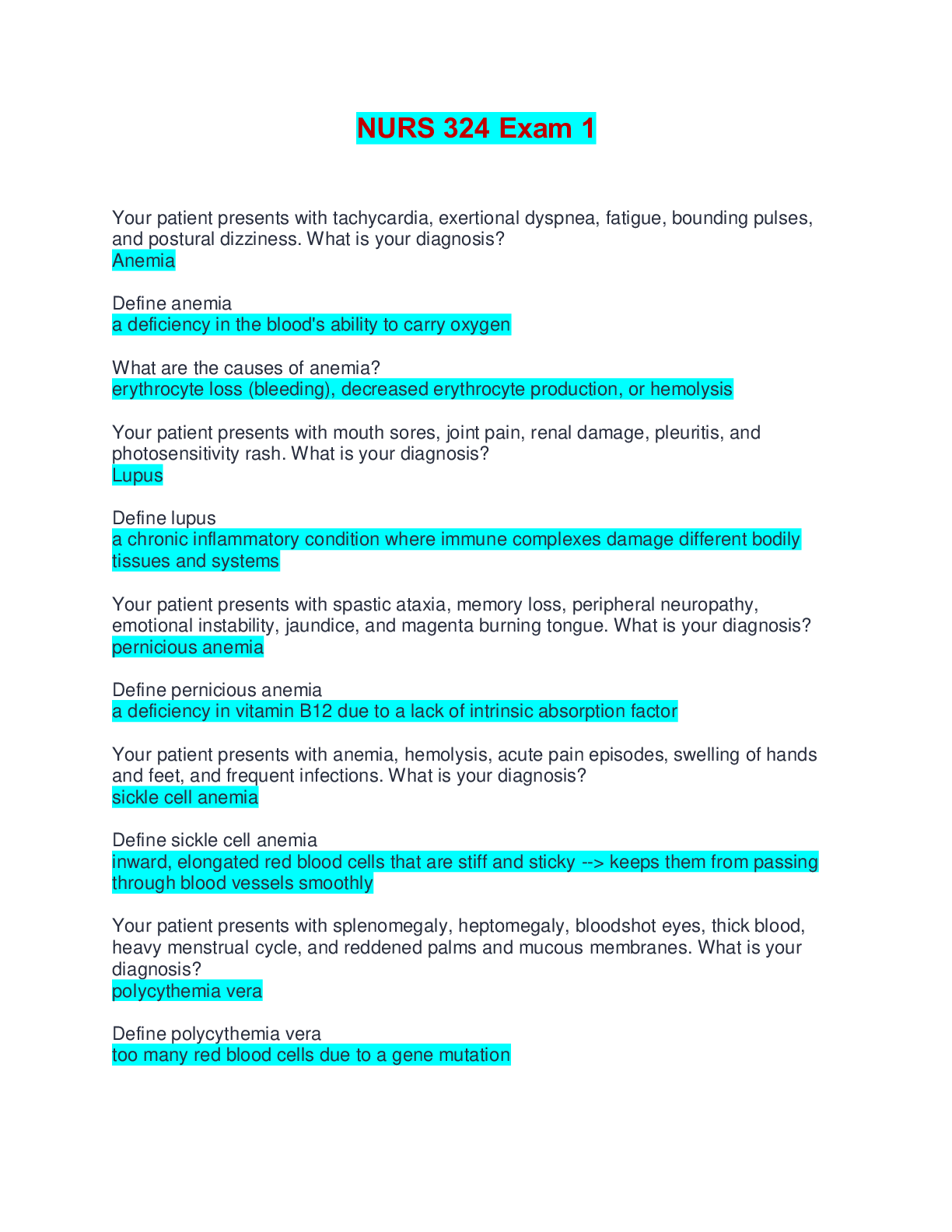
NURS 324 EXAM 1 & 2 BUNDLE
NURS 324 EXAM 1 & 2 BUNDLE
By Nurse Henny 9 months ago
$22
2
Reviews( 0 )
$20.00
Can't find what you want? Try our AI powered Search
Document information
Connected school, study & course
About the document
Uploaded On
Sep 25, 2024
Number of pages
34
Written in
Additional information
This document has been written for:
Uploaded
Sep 25, 2024
Downloads
0
Views
15

